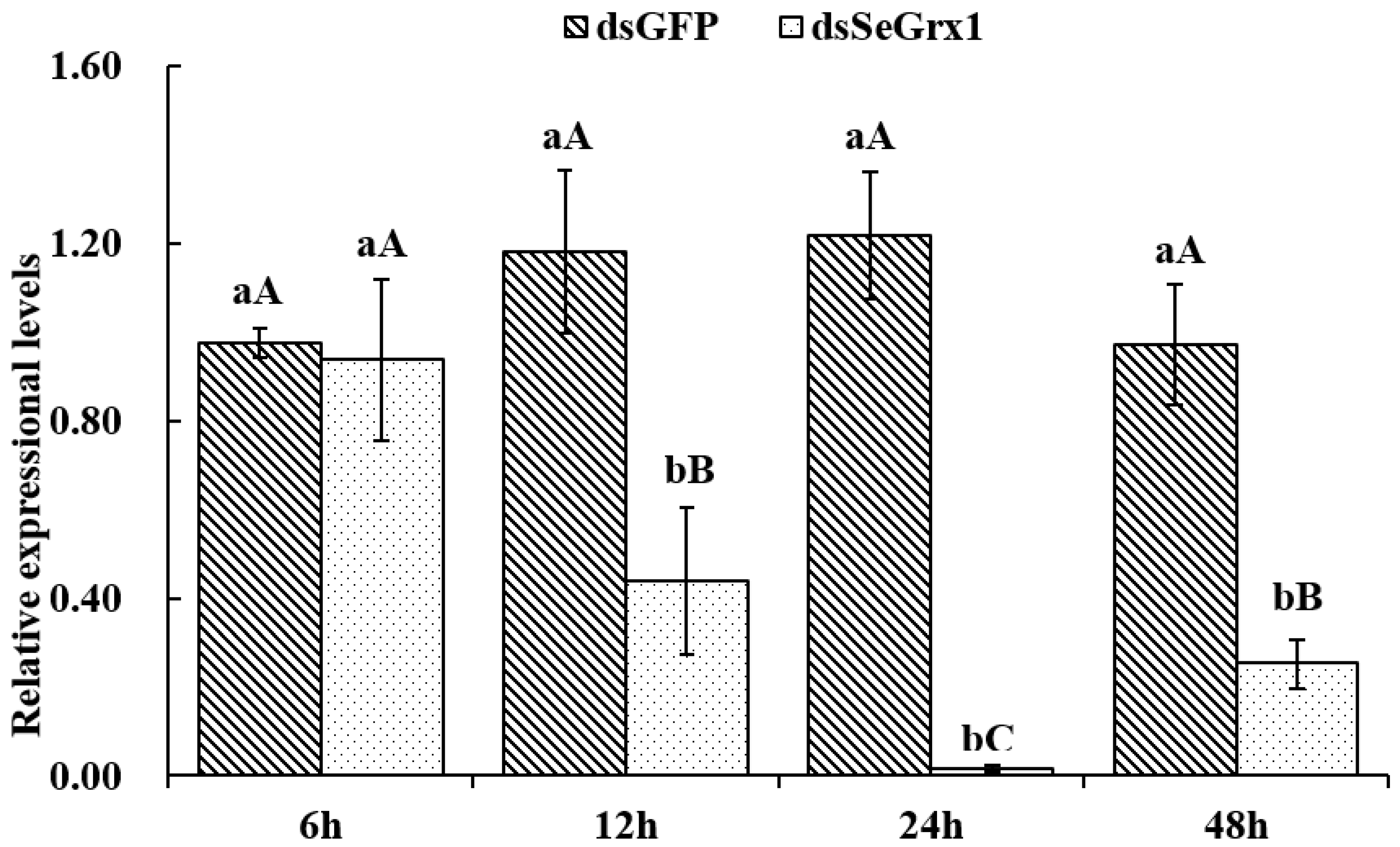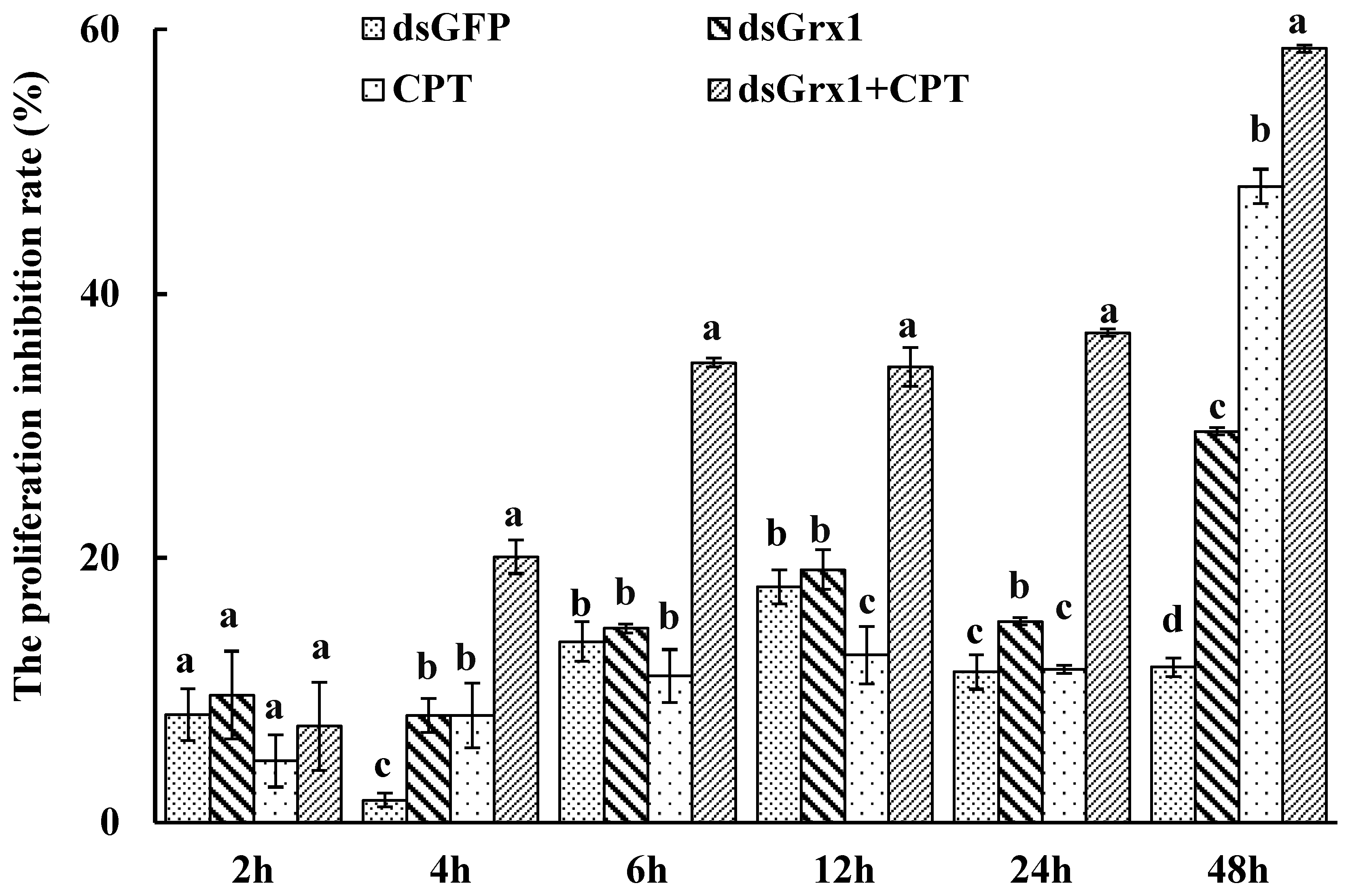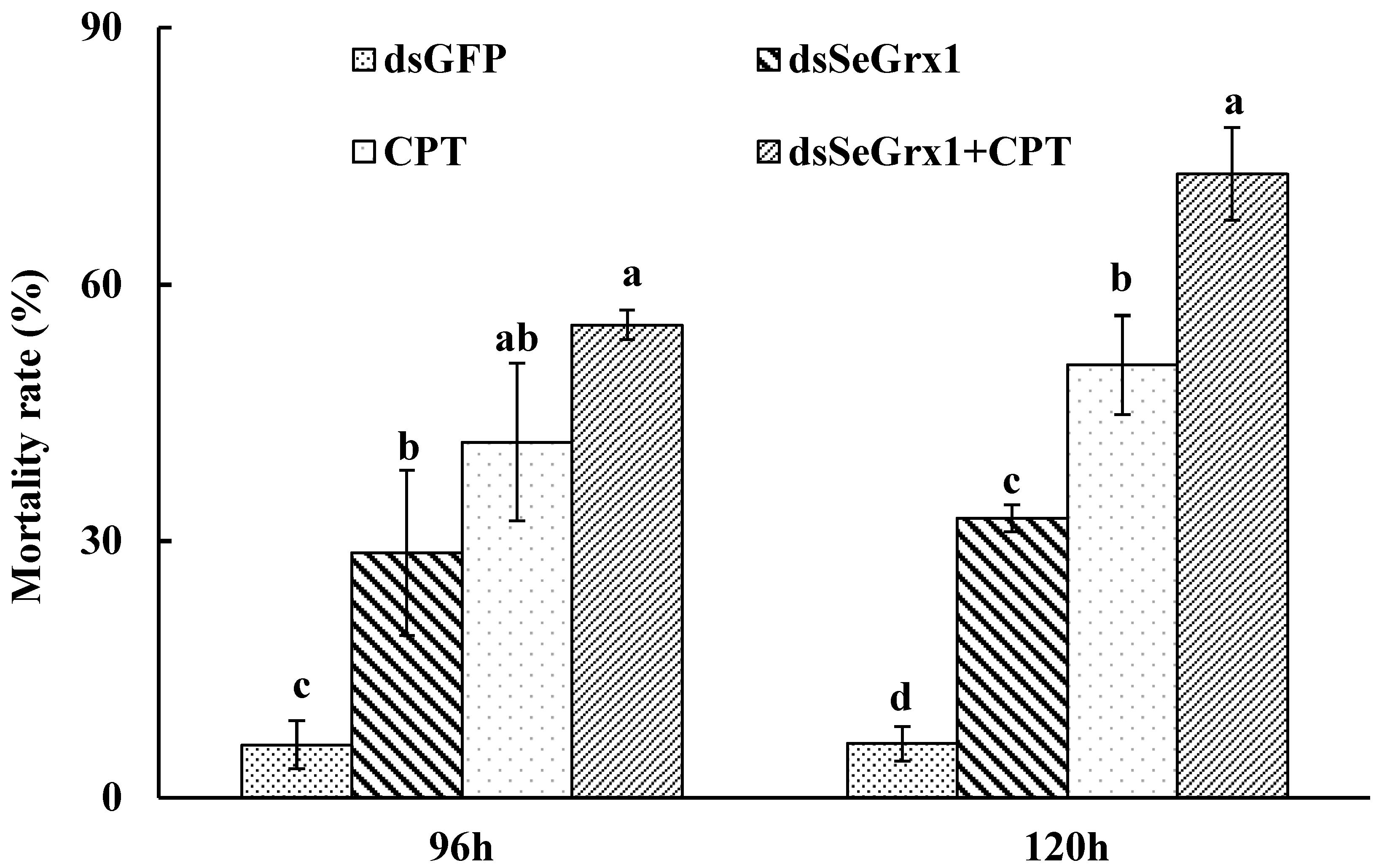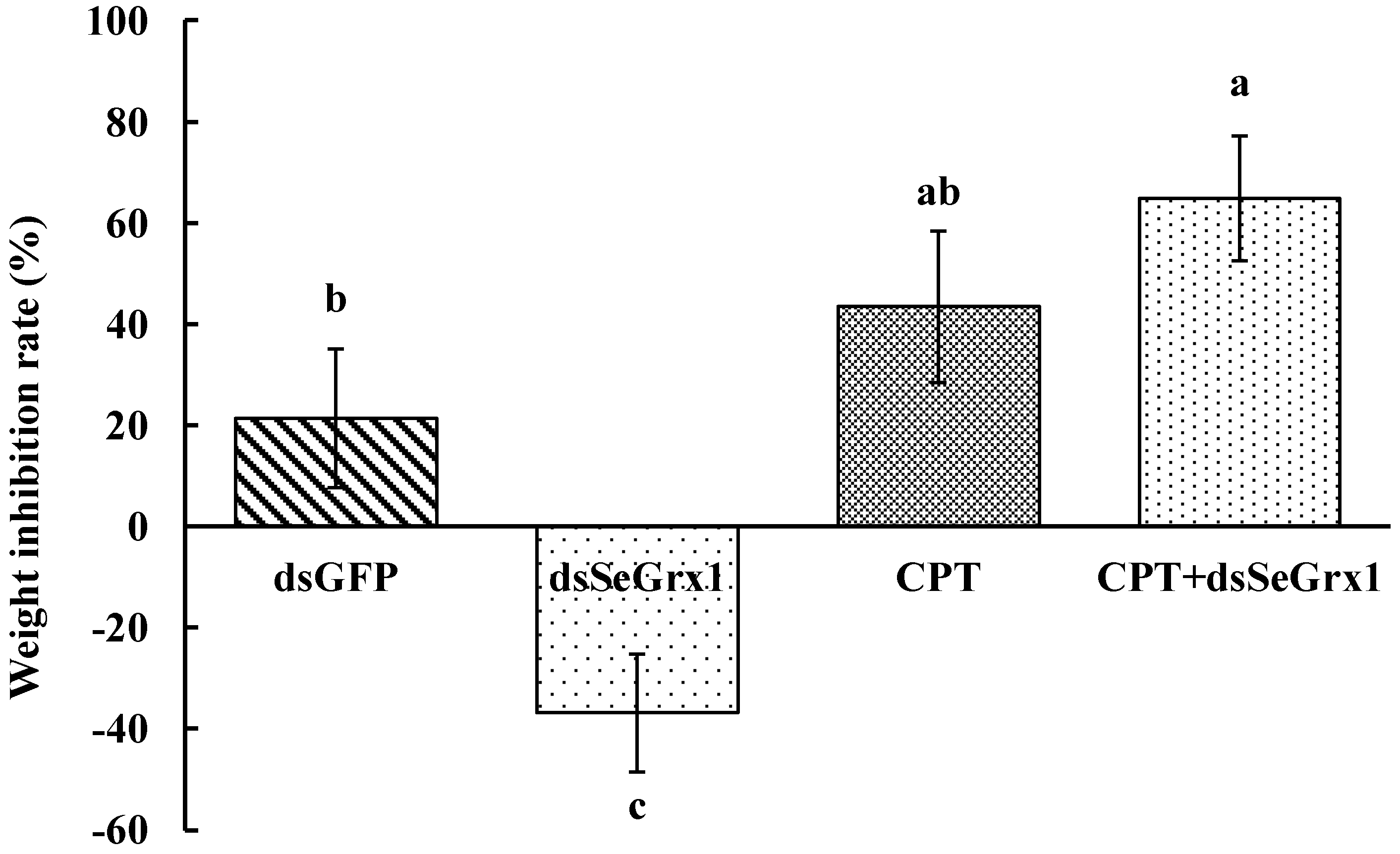Effect of RNAi Targeting SeGrx1 on the Cytotoxicity and Insecticide Susceptibility of Camptothecin in Spodoptera exigua
Abstract
:1. Introduction
2. Materials and Methods
2.1. Cell Lines and Insects
2.2. Total RNA Extraction and cDNA Synthesis
2.3. Double-Stranded RNA (dsRNA) Synthesis
2.4. Effect of RNAi on the Cytotoxicity of CPT
2.4.1. Cell Transfection with dsSeGrx1
2.4.2. CPT Exposure
2.4.3. Cell Viability Assay
2.5. CPT Sensitivity against S. exigua after RNAi
2.5.1. dsRNA Injection
2.5.2. Bioassays
2.6. Gene Expression with RT-qPCR
2.7. Statistical Analysis
3. Results and Discussion
3.1. RNAi Targeting SeGrx1 Increased the Cytotoxicity of CPT in IOZCAS-Spex-II Cells
3.2. RNAi Targeting SeGrx1 Increased the Sensitivity of CPT against S. exigua
4. Conclusions
Author Contributions
Funding
Institutional Review Board Statement
Informed Consent Statement
Data Availability Statement
Acknowledgments
Conflicts of Interest
References
- Fernandes, A.P.; Holmgren, A. Glutaredoxins: Glutathione-Dependent Redox Enzymes with Functions Far Beyond a Simple Thioredoxin Backup System. Antioxid. Redox Signal. 2004, 6, 63–74. [Google Scholar] [CrossRef]
- Ogata, F.T.; Branco, V.; Vale, F.F.; Coppo, L. Glutaredoxin: Discovery, Redox Defense and Much More. Redox Biol. 2021, 43, 101975. [Google Scholar] [CrossRef]
- Abdalla, M.; Eltayb, W.A.; Yousif, A. Comparison of Structures among Saccharomyces cerevisiae Grxs Proteins. Genes Environ. 2018, 40, 17. [Google Scholar] [CrossRef] [Green Version]
- Lillig, C.H.; Berndt, C.; Holmgren, A. Glutaredoxin Systems. Biochim. Biophys. Acta. 2008, 1780, 1304–1317. [Google Scholar] [CrossRef]
- Maghool, S.; La Fontaine, S.; Maher, M.J. High-Resolution Crystal Structure of the Reduced Grx1 from Saccharomyces cerevisiae. Acta Crystallogr. F Struct. Biol. Commun. 2019, 75 Pt 5, 392–396. [Google Scholar] [CrossRef]
- Matsui, R.; Ferran, B.; Oh, A.; Croteau, D.; Shao, D.; Han, J.; Pimentel, D.R.; Bachschmid, M.M. Redox Regulation via Glutaredoxin-1 and Protein S-Glutathionylation. Antioxid. Redox Signal. 2020, 32, 677–700. [Google Scholar] [CrossRef]
- Sun, J.; Wei, X.; Lu, Y.; Cui, M.; Li, F.; Lu, J.; Liu, Y.; Zhang, X. Glutaredoxin 1 (GRX1) Inhibits Oxidative Stress and Apoptosis of Chondrocytes by Regulating CREB/HO-1 in Osteoarthritis. Mol. Immunol. 2017, 90, 211–218. [Google Scholar] [CrossRef]
- Guo, Y.; Liu, Y.; Zhao, S.; Xu, W.; Li, Y.; Zhao, P.; Wang, D.; Cheng, H.; Ke, Y.; Zhang, X. Oxidative Stress-Induced FABP5 S-Glutathionylation Protects Against Acute Lung Injury by Suppressing Inflammation in Macrophages. Nat. Commun. 2021, 12, 7094. [Google Scholar] [CrossRef]
- Lozano, R.M.; Yee, B.C.; Buchanan, B.B. Thioredoxin-Linked Reductive Inactivation of Venom Neurotoxins. Arch. Biochem. Biophys. 1994, 309, 356–362. [Google Scholar] [CrossRef]
- Yao, P.; Chen, X.; Yan, Y.; Liu, F.; Zhang, Y.; Guo, X.; Xu, B. Glutaredoxin 1, Glutaredoxin 2, Thioredoxin 1, and Thioredoxin Peroxidase 3 Play Important Roles in Antioxidant Defense in Apis cerana cerana. Free Radic. Biol. Med. 2014, 68, 335–346. [Google Scholar] [CrossRef]
- Zhang, S.D.; Shen, Z.J.; Liu, X.M.; Li, Z.; Zhang, Q.W.; Liu, X.X. Molecular Identification of Three Novel Glutaredoxin Genes that Play Important Roles in Antioxidant Defense in Helicoverpa armigera. Insect Biochem. Mol. Biol. 2016, 75, 107–116. [Google Scholar] [CrossRef] [PubMed]
- Shen, Z.J.; Zhang, S.D.; Liu, Y.J.; Liu, X.M.; Li, Z.; Zhang, Q.W.; Liu, X.X. Functional Analysis by RNAi of an Glutaredoxin Gene in Helicoverpa armigera. J. Insect Physiol. 2018, 106, 98–105. [Google Scholar] [CrossRef] [PubMed]
- An, S.; Zhang, Y.; Wang, T.; Luo, M.; Li, C. Molecular Characterization of Glutaredoxin 2 from Ostrinia furnacalis. Integr. Zool. 2013, 8 (Suppl. 1), 30–38. [Google Scholar] [CrossRef] [PubMed]
- Zhang, L.; Zhang, Y.; He, W.; Ma, D.; Jiang, H. Effects of Camptothecin and Hydroxycamptothecin on Insect Cell Lines Sf21 and IOZCAS-Spex-II. Pest Manag. Sci. 2011, 68, 652–657. [Google Scholar] [CrossRef]
- Salvia, R.; Grossi, G.; Amoresano, A.; Scieuzo, C.; Nardiello, M.; Giangrande, C.; Laurenzana, I.; Ruggieri, V.; Bufo, S.A.; Vinson, S.B.; et al. The Multifunctional Polydnavirus TnBVANK1 Protein: Impact on Host Apoptotic Pathway. Sci. Rep. 2017, 7, 11775. [Google Scholar] [CrossRef]
- Ren, X.; Zhang, L.; Zhang, Y.; Mao, L.; Jiang, H. Oxidative Stress Induced by Camptothecin and Hydroxyl-Camptothecin in IOZCAS-Spex-II Cells of Spodoptera exigua Hübner. Comp. Biochem. Physiol. C Toxicol. Pharmacol. 2019, 216, 52–59. [Google Scholar] [CrossRef]
- Ren, X.; Zhang, L.; Zhang, Y.; Mao, L.; Jiang, H. Mitochondria Response to Camptothecin and Hydroxycamptothecine-Induced Apoptosis in Spodoptera exigua Cells. Pestic. Biochem. Physiol. 2017, 140, 97–104. [Google Scholar] [CrossRef]
- Yang, F.L.; Zhao, Z.Z.; Wang, Y.H.; Zhang, L.; Zhang, Y.N.; Mao, L.G.; Jiang, H.Y. Prokaryotic Expression, Purification and Enzymatic Characterization of SeGrx1 of the Beet Armyworm, Spodoptera exigua (Lepidoptera: Noctuidae). Acta Entomol. Sin. 2020, 63, 952–960. [Google Scholar]
- Tang, B.; Wang, S.; Zhang, F. Two Storage Hexamerins from the Beet Armyworm Spodoptera exigua: Cloning, Characterization and the Effect of Gene Silencing on Survival. BMC Mol. Biol. 2010, 11, 65. [Google Scholar] [CrossRef] [Green Version]
- Ren, X.L.; Ma, Y.; Cui, J.J.; Li, G.Q. RNA Interference-Mediated Knockdown of Three Putative Aminopeptidases N Affects Susceptibility of Spodoptera exigua Larvae to Bacillus thuringiensis Cry1Ca. J. Insect Physiol. 2014, 67, 28–36. [Google Scholar] [CrossRef]
- Gurusamy, D.; Mogilicherla, K.; Shukla, J.N.; Palli, S.R. Lipids Help Double-Stranded RNA in Endosomal Escape and Improve RNA Interference in the Fall Armyworm, Spodoptera frugiperda. Arch. Insect Biochem. Physiol. 2020, 104, e21678. [Google Scholar] [CrossRef] [PubMed]
- Hafeez, M.; Liu, S.; Jan, S.; Shi, L.; Fernández-Grandon, G.M.; Gulzar, A.; Ali, B.; Rehman, M.; Wang, M. Knock-Down of Gossypol-Inducing Cytochrome P450 Genes Reduced Deltamethrin Sensitivity in Spodoptera exigua (Hübner). Int. J. Mol. Sci. 2019, 20, 2248. [Google Scholar] [CrossRef] [PubMed] [Green Version]
- Zuo, Y.Y.; Huang, J.L.; Wang, J.; Feng, Y.; Han, T.T.; Wu, Y.D.; Yang, Y.H. Knockout of a P-Glycoprotein Gene Increases Susceptibility to Abamectin and Emamectin Benzoate in Spodoptera exigua. Insect Mol. Biol. 2018, 27, 36–45. [Google Scholar] [CrossRef] [PubMed]
- Vandesompele, J.; De Preter, K.; Pattyn, F.; Poppe, B.; Van Roy, N.; De Paepe, A.; Speleman, F. Accurate Normalization of Real-time Quantitative RT-PCR Data by Geometric Averaging of Multiple Internal Control Genes. Genome Biol. 2002, 3, RESEARCH0034. [Google Scholar] [CrossRef] [Green Version]
- Huvenne, H.; Smagghe, G. Mechanisms of dsRNA Uptake in Insects and Potential of RNAi for Pest Control: A Review. J. Insect Physiol. 2010, 56, 227–235. [Google Scholar] [CrossRef]
- Manta, B.; Möller, M.N.; Bonilla, M.; Deambrosi, M.; Grunberg, K.; Bellanda, M.; Comini, M.A.; Ferrer-Sueta, G. Kinetic Studies Reveal a Key Role of a Redox-Active Glutaredoxin in the Evolution of the Thiol-Redox Metabolism of Trypanosomatid Parasites. J. Biol. Chem. 2019, 294, 3235–3248. [Google Scholar] [CrossRef] [Green Version]
- Butt, J.N. Explorations of time and electrochemical potential: Opportunities for fresh perspectives on signalling proteins. Biochem. Soc. Trans. 2014, 42, 47–51. [Google Scholar] [CrossRef]
- Lillig, C.H.; Lönn, M.E.; Enoksson, M.; Fernandes, A.P.; Holmgren, A. Short Interfering RNA-Mediated Silencing of Glutaredoxin 2 Increases the Sensitivity of HeLa Cells Toward Doxorubicin and Phenylarsine Oxide. Proc. Natl. Acad. Sci. USA 2004, 101, 13227–13232. [Google Scholar] [CrossRef] [Green Version]
- Linares, G.R.; Xing, W.; Govoni, K.E.; Chen, S.T.; Mohan, S. Glutaredoxin 5 Regulates Osteoblast Apoptosis by Protecting Against Oxidative Stress. Bone 2009, 44, 795–804. [Google Scholar] [CrossRef] [Green Version]
- Shu, B.; Yang, X.; Dai, J.; Yu, H.; Yu, J.; Li, X.; Cao, L.; Lin, J. Effects of Camptothecin on Histological Structures and Gene Expression Profiles of Fat Bodies in Spodoptera frugiperda. Ecotoxicol. Environ. Saf. 2021, 228, 112968. [Google Scholar] [CrossRef]
- Shu, B.; Zou, Y.; Yu, H.; Zhang, W.; Li, X.; Cao, L.; Lin, J. Growth Inhibition of Spodoptera frugiperda Larvae by Camptothecin Correlates with Alteration of the Structures and Gene Expression Profiles of the Midgut. BMC Genomics 2021, 22, 391. [Google Scholar] [CrossRef] [PubMed]
- Christiaens, O.; Niu, J.; Nji Tizi Taning, C. RNAi in Insects: A Revolution in Fundamental Research and Pest Control Applications. Insects 2020, 11, 415. [Google Scholar] [CrossRef] [PubMed]
- Katoch, R.; Sethi, A.; Thakur, N.; Murdock, L.L. RNAi for Insect Control: Current Perspective and Future Challenges. Appl. Biochem. Biotechnol. 2013, 171, 847–873. [Google Scholar] [CrossRef] [PubMed]
- Zhang, R.; Wang, B.; Grossi, G.; Falabella, P.; Liu, Y.; Yan, S.; Lu, J.; Xi, J.; Wang, G. Molecular Basis of Alarm Pheromone Detection in Aphids. Curr. Biol. 2017, 27, 55–61. [Google Scholar] [CrossRef] [Green Version]
- Liu, D.; De Schutter, K.; Chen, P.; Smagghe, G. The N-Glycosylation-Related Genes as Potential Targets for RNAi-Mediated Pest Control of the Colorado Potato Beetle (Leptinotarsa Decemlineata). Pest Manag. Sci. 2021. [Google Scholar] [CrossRef]
- Yu, R.; Xu, X.; Liang, Y.; Tian, H.; Pan, Z.; Jin, S.; Wang, N.; Zhang, W. The Insect Ecdysone Receptor is a Good Potential Target for RNAi-Based Pest Control. Int. J. Biol. Sci. 2014, 10, 1171–1180. [Google Scholar] [CrossRef] [Green Version]
- Yoon, J.S.; Koo, J.; George, S.; Palli, S.R. Evaluation of Inhibitor of Apoptosis Genes as Targets for RNAi-Mediated Control of Insect Pests. Arch. Insect Biochem. Physiol. 2020, 104, e21689. [Google Scholar] [CrossRef]
- Liu, Y.; Zhu, F.; Shen, Z.; Moural, T.W.; Liu, L.; Li, Z.; Liu, X.; Xu, H. Glutaredoxins and Thioredoxin Peroxidase Involved in Defense of Emamectin Benzoate Induced Oxidative Stress in Grapholita molesta. Pestic. Biochem. Physiol. 2021, 176, 104881. [Google Scholar] [CrossRef]






| Purpose | Name | Sequences (5′-3′) | Size (bp) |
|---|---|---|---|
| dsRNA syntheses | dsSeGrx1 F | TAATACGACTCACTATAGGGAGAGGGCTCTCTGGCAAGCAAAA | 198 |
| dsSeGrx1 R | TAATACGACTCACTATAGGGAGAGTCGCGCTCATCCAGTTCAT | ||
| dsGFP F | TAATACGACTCACTATAGGGAAGTTCAGCGTGTCC | 520 | |
| dsGFP R | TAATACGACTCACTATAGGGACTTCTCGTTGGGGTC | ||
| RT-qPCR | SeGrx1 F | GCGATTCAAGAAAACCTGGCT | 130 |
| SeGrx1 R | AGCATGGGCTCTAGTTTGCC | ||
| α-Tubulin F | GGAAGGAGAGTTCTCCGAGG | 152 | |
| α-Tubulin R | GGGGAATGTATTACGGTGCG | ||
| GAPDH F | GAAAACACCGGTGGACTCAA | 134 | |
| GAPDH R | GGCACCGTTGATATGCAAGA |
Publisher’s Note: MDPI stays neutral with regard to jurisdictional claims in published maps and institutional affiliations. |
© 2022 by the authors. Licensee MDPI, Basel, Switzerland. This article is an open access article distributed under the terms and conditions of the Creative Commons Attribution (CC BY) license (https://creativecommons.org/licenses/by/4.0/).
Share and Cite
Yang, F.; Zhang, L.; Zhang, Y.; Mao, L.; Zhu, L.; Liu, X.; Jiang, H. Effect of RNAi Targeting SeGrx1 on the Cytotoxicity and Insecticide Susceptibility of Camptothecin in Spodoptera exigua. Agriculture 2022, 12, 930. https://doi.org/10.3390/agriculture12070930
Yang F, Zhang L, Zhang Y, Mao L, Zhu L, Liu X, Jiang H. Effect of RNAi Targeting SeGrx1 on the Cytotoxicity and Insecticide Susceptibility of Camptothecin in Spodoptera exigua. Agriculture. 2022; 12(7):930. https://doi.org/10.3390/agriculture12070930
Chicago/Turabian StyleYang, Fulai, Lan Zhang, Yanning Zhang, Liangang Mao, Lizhen Zhu, Xingang Liu, and Hongyun Jiang. 2022. "Effect of RNAi Targeting SeGrx1 on the Cytotoxicity and Insecticide Susceptibility of Camptothecin in Spodoptera exigua" Agriculture 12, no. 7: 930. https://doi.org/10.3390/agriculture12070930







